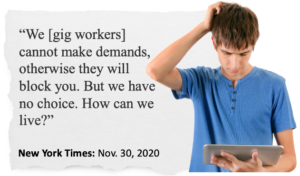 Our program won USCM’s national prize for job creation initiatives. Current models of irregular work kill jobs. Systematic local support creates them.
Our program won USCM’s national prize for job creation initiatives. Current models of irregular work kill jobs. Systematic local support creates them.
Disrupting the race
Gig work companies have untruthfully pushed a narrative that work flexibility is incompatible with employment rights. This idea has stuck. Many officials fear that irregular work is inherently bad and a publicly run platform can only exacerbate today’s race to the floor on wages, eroding jobs. Throughout the economy, that race is now an impact of platforms for ad-hoc work.
 But low pay and lack of benefits is a requirement of Silicon Valley business models, not an integral aspect of flexible work. Tech. startups must deduct enormous charges from workers’ earnings to repay investors.
But low pay and lack of benefits is a requirement of Silicon Valley business models, not an integral aspect of flexible work. Tech. startups must deduct enormous charges from workers’ earnings to repay investors.
A publicly provided marketplace disrupts today’s race to the floor.  There are no investors. Each work-seeker has more choices, across more types of work, with data to inform decisions about which they could most profitably pursue. Bad employers can be deselected. With lower overheads, wages can rise. That empowerment makes job-creation logical if need for workers is regular. On-demand workers are no longer in the bargain bin.
There are no investors. Each work-seeker has more choices, across more types of work, with data to inform decisions about which they could most profitably pursue. Bad employers can be deselected. With lower overheads, wages can rise. That empowerment makes job-creation logical if need for workers is regular. On-demand workers are no longer in the bargain bin.
Proven candidates
 Current models of gig work can penalize job progression. Accept employment from someone who booked you on Handy.com for example and you could be contractually obliged to pay Handy $100 for “off-platform” activity. But public agencies regard transitions to a job as a target outcome. Our GoodFlexi platform offers a range of tools to get irregulars into jobs.
Current models of gig work can penalize job progression. Accept employment from someone who booked you on Handy.com for example and you could be contractually obliged to pay Handy $100 for “off-platform” activity. But public agencies regard transitions to a job as a target outcome. Our GoodFlexi platform offers a range of tools to get irregulars into jobs.
So, imagine you’re a hotel manager with a housekeeper vacancy. You could advertise, then a few weeks later start on-boarding a candidate who did well at interview. Or, you could immediately search for provenly reliable irregular workers, with verifiable hospitality experience, living within 5 miles and keen to move to regular hours. You might create a shortlist then book them to work at your hotel next time you have full occupancy and need top-up staff. Or you could invite each in for a chat.
Our directory of work-seekers has multiple privacy protections and controls to be configured by each intermediary. But we have set one of our demonstration platforms to be open to anyone. You can view it here. (None of the entities or people shown exist.)
The power of badges
Digital badging of traditional workers can be lumpy. Qualifications may take years to gain and typically must be reconfirmed before a job hire. In the more fluid workforce, badging may be more precise and useful. That assists job transitions. Any local implementation of our GoodFlexi platform offers three categories of badges:
- Credentials: This is any competency gained after training, checkout operator certification or a truck driving licence for example.
- Tags: These are anything else proven by the work-seeker that could attract opportunity or support. Are they a local resident? Long-term unemployed? Covid vacinated?
- Preferences: Is the person willing to lift loads? Work outdoors? Wear a uniform? Knowing Yes or No to each allows them to be aligned with the best-fit role offers.
Any Credential or Tag can be subject to an expiry date when applied to a worker by their employer of record. Bookings requiring the badge will then be blocked until it is renewed.

We also enable private badges, not displayed to anyone other than the individual and their employer. Examples include justice-involved, on an opioid support program, or recently laid off. Public agencies and philanthropies can target interventions, like subsidized employment, to these people and track their outcomes.
As ever with GoodFlexi, badges are under local control. There are system-level badges that can be applied to workers by any intermediary (standard competencies for example). But any region can create their own badges at two levels:
- Intermediary specific: An agency specializing in work for people with disabilities may want to capture particular competencies in especially granular detail.
- Client-specific: A family with complex childcare needs, a builder seeking top-up laborers, or a company wanting to badge any local worker they have inducted can have their own badges created and applied to workers according to their rules.
Badges can be created around whatever opens pathways. In one city we see a “Willing to work on boats” preference. It aligns hospitality workers immune to seasickness with the harbor’s tourist/party/events fleet. Other workers can be likewise monetizing attributes such as being a smoker; it can make them attractive to homecare companies struggling to find workers willing to serve tobacco-using clients. De-commoditizing each person by making their unique mix of attributes accessible – for immediate work, or job interview offers – is the priority.
Supporting “incrementals”
 “You start your new job on Monday” can be a terrifying phrase. Individuals who have been out of the labor market or lack confidence may respond better to “Could you handle a couple of hours work this afternoon, or perhaps a few later in the week?”.
“You start your new job on Monday” can be a terrifying phrase. Individuals who have been out of the labor market or lack confidence may respond better to “Could you handle a couple of hours work this afternoon, or perhaps a few later in the week?”.
We call them “incrementals”; people who need their own way into the workforce, at their pace. Ramping up to full time remains a constant possibility, but right now; they need to dip a toe into the labor market, not be thrown in. Prospects for this approach are increased if pools of “Guaranteed work” can be lined up in advance. So, as example, a warehouse prone to peak rushes might be enticed to give newcomers a chance on their picking line as part of a supervised team. That way, incrementals, could be assured of maybe 40 hours of work, when they felt able, and managers needed pickers. They then start building a track record of reliability in bite sized chunks.
This could still be daunting. Interventions such as a “work buddy” who accompanies the person to the start of each booking can be cost-effectively managed in a local market for all types of hourly labor. A group of buddies might be inducted and overseen by a workforce board or charity. Selection would use badging data to find candidates.
Early data
 A stream of real-time information about movements in the flexible labor market can reveal trends in traditional employment before they show in BLS data. Did bookings of inbound contact center skills rise last month? Do childcare day centers show increased demand for on-demand support workers? Is there a surge of people with office receptionist skills? How many workers gained a “dental hygienist certified” badge this year?
A stream of real-time information about movements in the flexible labor market can reveal trends in traditional employment before they show in BLS data. Did bookings of inbound contact center skills rise last month? Do childcare day centers show increased demand for on-demand support workers? Is there a surge of people with office receptionist skills? How many workers gained a “dental hygienist certified” badge this year?
Each of those types of work are better performed by jobholders; the need for a worker is largely regular. If there’s an uptick in utilization of top-up flexible workers with those skills, there’s probably jobs to be created if full time work-seekers can be trained. GoodFlexi can find the workers wanting to transition to regularity with relevant, or adjoining, skills ready for best use of a training budget.
Likewise, a flood of people with receptionist skills seeking work might signal a need for displaced worker support because of layoffs. A report can show what related types of work are currently in demand.
→ Training
